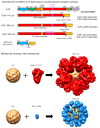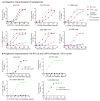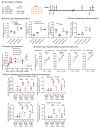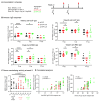Systemic and Mucosal Humoral Immune Responses to Lumazine Synthase 60-mer Nanoparticle SARS-CoV-2 Vaccines
- PMID: 40872867
- PMCID: PMC12390229
- DOI: 10.3390/vaccines13080780
Systemic and Mucosal Humoral Immune Responses to Lumazine Synthase 60-mer Nanoparticle SARS-CoV-2 Vaccines
Abstract
Background: Vaccines that stimulate systemic and mucosal immunity to a level required to prevent SARS-CoV-2 infection and transmission are an unmet need. Highly protective hepatitis B and human papillomavirus nanoparticle vaccines highlight the potential of multivalent nanoparticle vaccine platforms to provide enhanced immunity. Here, we report the construction and characterization of self-assembling 60-subunit icosahedral nanoparticle SARS-CoV-2 vaccines using the bacterial enzyme lumazine synthase (LuS). Methods and Results: Nanoparticles displaying prefusion-stabilized SARS-CoV-2 spike ectodomains fused to the surface-exposed amino terminus of LuS were designed using structure-guided approaches. Negative stain-electron microscopy studies of purified nanoparticles were consistent with self assembly into 60-mer nanoparticles displaying 20 spike trimers. After two intramuscular doses, these purified spike-LuS nanoparticles elicited significantly higher SARS-CoV-2 neutralizing activity than spike trimers in vaccinated mice. Furthermore, intramuscular DNA priming and intranasal boosting with a SARS-CoV-2 LuS nanoparticle vaccine stimulated mucosal IgA responses. Conclusion: These data identify LuS nanoparticles as highly immunogenic SARS-CoV-2 vaccine candidates and support the further development of this platform against SARS-CoV-2 and its emerging variants.
Keywords: SARS-CoV-2; lumazine synthase; mucosal immunity; nanoparticle; vaccine.
Conflict of interest statement
The authors declare no conflicts of interest.
Figures






References
-
- World Health Organization WHO Coronavirus (COVID-19) Dashboard. [(accessed on 7 February 2025)]. Available online: https://data.who.int/dashboards/covid19/
Grants and funding
LinkOut - more resources
Full Text Sources
Miscellaneous

